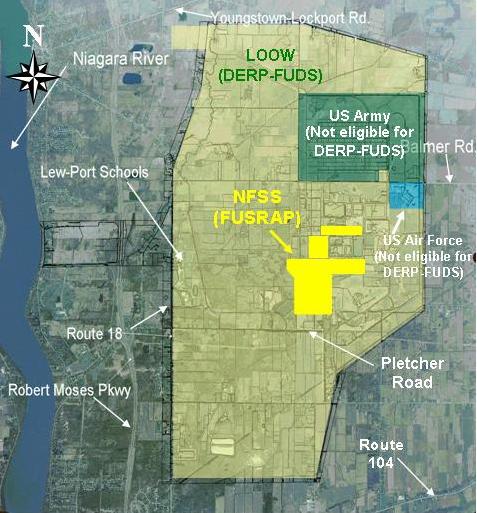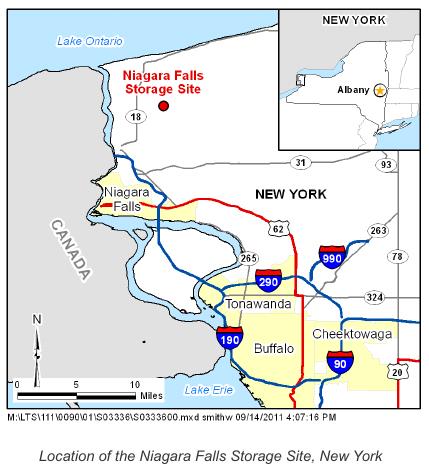The EEOICPA was passed in 2000. It provides compensation to workers who became ill as a result of their employment manufacturing nuclear weapons in the USA, as well as their spouses, children, and grandchildren. Lake Ontario Ordnance Works EEOICPA coverage is available for qualified former Workers and their families.
Are you eligible for compensation? If you or a family member worked at this or another DOE facility and became ill, you may be entitled to compensation of up to $400K plus medical benefits. Call EEOICPA Counsel Hugh Stephens at 1-855-548-4494 or fill out our free claim evaluation, We can help even if you’ve already filed, even if your claim was denied!
Here, we have compiled publicly available information and documentation about the facilities covered by the Act to clarify how their activities relate to the Energy Employees Occupational Illness Compensation Program Act.
Lake Ontario Ordnance Works
Also Known As: LOOW, Niagara Falls Storage Site (NFSS), Niagara Falls Vicinity Properties
State: New York
Location: Niagara Falls
Time Period: 1944-1997
Facility Type: Department of Energy
Facility Description: In 1944, the Manhattan Engineer District (MED) obtained a portion of the Lake Ontario Ordnance Works (LOOW) from the Department of Defense (DOD) for storage of low-grade radioactive residues resulting from pitchblende ore processing at the Linde Air Products facility. In 1948, when the DOD decommissioned the LOOW, the AEC acquired 1511 acres of the site, including the original storage areas. The AEC declared most of this property as excess in 1955, and by 1968 the General Services Administration was able to dispose of 1298 acres, with 213 acres remaining under AEC control. In 1975, additional property was transferred to the town of Lewiston, leaving the present 191-acre site. The DOE portion of the site became known as the Niagara Falls Storage Site (NFSS). The site remained under DOE control until 1997 when it was transferred to the Corps of Engineers under the FUSRAP program.
Following World War II, Linde’s refinery was decommissioned and contaminated equipment was disposed at the LOOW. Contaminated materials from other MED/AEC facilities were also shipped to LOOW for disposal. Beginning in 1949, residues from operations at the Mallinckrodt Chemical Works were shipped to LOOW for storage. During the early 1950’s, the AEC portion of the LOOW was also used for interim storage of uranium and thorium billets and rods being processed by various New York companies.
During 1953-1954, the AEC constructed a boron isotope separation plant at the LOOW, which began operations in 1954. The operating contractor for this plant was the Hooker Electrochemical Company which referred to it as Plant 31 (P-31).. In 1958, the facility was placed on stand-by and a maintenance contractor, Page Airways, was employed for routine surveillance. The operation was restarted in 1964, with Nuclear Materials and Equipment Company as the operating contractor. In 1971, the boron facility was again placed on stand-by with National Lead Company of Ohio (NLO) as the caretaker. In 1981, Bechtel National took over the caretaker contract and began plans for remedial work at the site. Clean-up began in 1982.
CONTRACTORS: Hooker Electrochemical (1953-1958); Page Airways (1958-1964); Nuclear Materials and Equipment Company (NUMEC) (1964- 1971); National Lead Company of Ohio (1971-1981); Bechtel National (1981-1997)
Listing:
Lake Ontario Ordnance Works is listed as a Department of Energy (DOE) site under the EEOICPA.
DOE Contractor:
DOE contractors associated with this class include Hooker Electrochemical, Page Airways, Nuclear Materials and Equipment Co., National Lead Company of Ohio, and Bechtel National.
Special Exposure Cohort (SEC) Classes:
All employees of the DOE, its predecessor agencies, and their contractors and subcontractors who worked at Lake Ontario Ordnance Works in Niagara Falls, New York from January 1, 1944 through December 31, 1953, for a number of work days aggregating at least 250 work days, occurring either solely under this employment, or in combination with work days within the parameters established for one or more other classes of employees in the SEC.
Compensation:
As of 01/08/2023, the total compensation paid under Parts B and E of the EEOICPA, including medical compensation, for workers suffering from the effects of having worked at Lake Ontario Ordnance Works is $4,725,110.Click here for a current accounting of compensation paid to former LOOW Workers under the EEOICPA.
Lake Ontario Ordnance Works Workers:
If you or your parent worked at this or any other DOE or AWE facility and became ill, you may be entitled to compensation of up to $400K plus medical benefits from the US Department of Labor. Call EEOICPA Counsel Hugh Stephens at 1-855-EEOICPA (336-4272) or fill out the form to the right, whether or not you have already filed a claim and even if your claim has been accepted or denied.
We can help with all OWCP (Federal Workers Compensation) claims, impairments, wage loss and health care. 2495 Main Street, Suite 442 Buffalo, NY.
*Site Description and History:
The Niagara Falls Storage Site, New York, is a 191-acre site located on Pletcher Road in the towns of Lewiston and Porter, Niagara County, in northwestern New York. It is approximately 10 miles north of the city of Niagara Falls and 19 miles northwest of Buffalo, New York. The site is a remnant of the U.S. Army’s 7,500-acre Lake Ontario Ordnance Works. The property includes a 10-acre interim waste containment structure (IWCS) for radioactive waste and residues, which is covered by an interim cap designed to retard radon emissions and rainwater infiltration, and three buildings: Building 401, which contains isolated areas of fixed, low-level radioactive contamination, and two maintenance buildings.
In 1944, during World War II, the Manhattan Engineer District (MED) used the site for the storage and transshipment of radioactive residues and wastes from the processing of uranium ore. By 1948, the War Assets Administration had transferred or sold 6,000 acres of the original property, and the remaining 1,500 acres were subsequently given to the newly formed Atomic Energy Commission (AEC). From 1955 to 1975, more than 1,300 acres were transferred or sold to private concerns, leaving the current 191 acres that are owned by the U.S. Department of Energy (DOE).
In 1943, Building 401 was used as the powerhouse for the trinitrotoluene (TNT) plant at the Lake Ontario Ordnance Works; operations involving the manufacture of TNT only continued for 1 year. The building was used to manufacture boron-10, which is not radioactive, from 1953 to 1959 and from 1965 to 1971.
In 1952, drums containing radioactive uranium ore processing residues (K-65) were stored in a silo, which has since been demolished. In the 1980s, DOE placed the residues in the engineered IWCS, which was completed in 1991. DOE began cleanup of the radioactive wastes in 1982 under the Formerly Utilized Sites Remedial Action Program (FUSRAP), and as of March 2004, DOE and USACE had consolidated approximately 235,000 cubic yards of contaminated material and 25,000 cubic yards of radioactive residues (of which approximately 4,000 cubic yards comprise K-65 high activity residues) into the IWCS. Although radiological contamination of soil exists throughout the site, it is at levels considerably below those of the materials stored in the IWCS. The primary contaminants of concern at the site are radium, thorium, and smaller amounts of uranium.
 **Source
**Source
DOCUMENTS:
NIOSH SEC Petition Evaluation Reports:
Petition 145 (Jan 1, 1944 to Dec 31, 1953)
SEC Petition Evaluation Report, Petition SEC-00145, Rev #: 0
Report Submittal Date: July 1, 2009


















